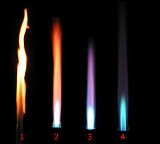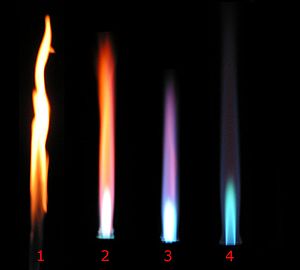
Premixed flame
Encyclopedia

Flame
A flame is the visible , gaseous part of a fire. It is caused by a highly exothermic reaction taking place in a thin zone...
in which the oxidizer has been mixed with the fuel
Fuel
Fuel is any material that stores energy that can later be extracted to perform mechanical work in a controlled manner. Most fuels used by humans undergo combustion, a redox reaction in which a combustible substance releases energy after it ignites and reacts with the oxygen in the air...
before it reaches the flame front. This creates a thin flame front as all of the reactants are readily available. If the mixture is rich, a diffusion flame
Diffusion flame
In combustion, a diffusion flame is a flame in which the oxidizer combines with the fuel by diffusion. As a result, the flame speed is limited by the rate of diffusion. Diffusion flames tend to burn slower and to produce more soot than premixed flames because there may not be sufficient oxidizer...
will generally be found farther downstream.
If the flow of the fuel–oxidizer mixture is laminar
Laminar flow
Laminar flow, sometimes known as streamline flow, occurs when a fluid flows in parallel layers, with no disruption between the layers. At low velocities the fluid tends to flow without lateral mixing, and adjacent layers slide past one another like playing cards. There are no cross currents...
, the flame speed
Flame speed
The flame speed is the measured rate of expansion of the flame front in a combustion reaction. Whereas flame speed is generally used for a fuel, a related term is explosive velocity, which is the same relationship measured for an explosive. Combustion engineers differentiate between the laminar...
of premixed flames is dominated by the chemistry. If the flow rate is below the flame speed, the flame will move upstream until the fuel is consumed or until it encounters a flame holder
Flame holder
A flame holder is a component of a jet engine designed to help maintain continual combustion.All continuous-combustion jet engines require a flame holder. A flame holder creates a low-speed eddy in the engine to prevent the flame from being blown out...
. If the flow rate is equal to the flame speed, we would expect a stationary flat flame front normal to the flow direction. If the flow rate is above the flame speed, the flame front will become conical such that the component of the velocity vector normal to the flame front is equal to the flame speed. As a result, the flame front of most premixed flames in daily life are roughly conical.

